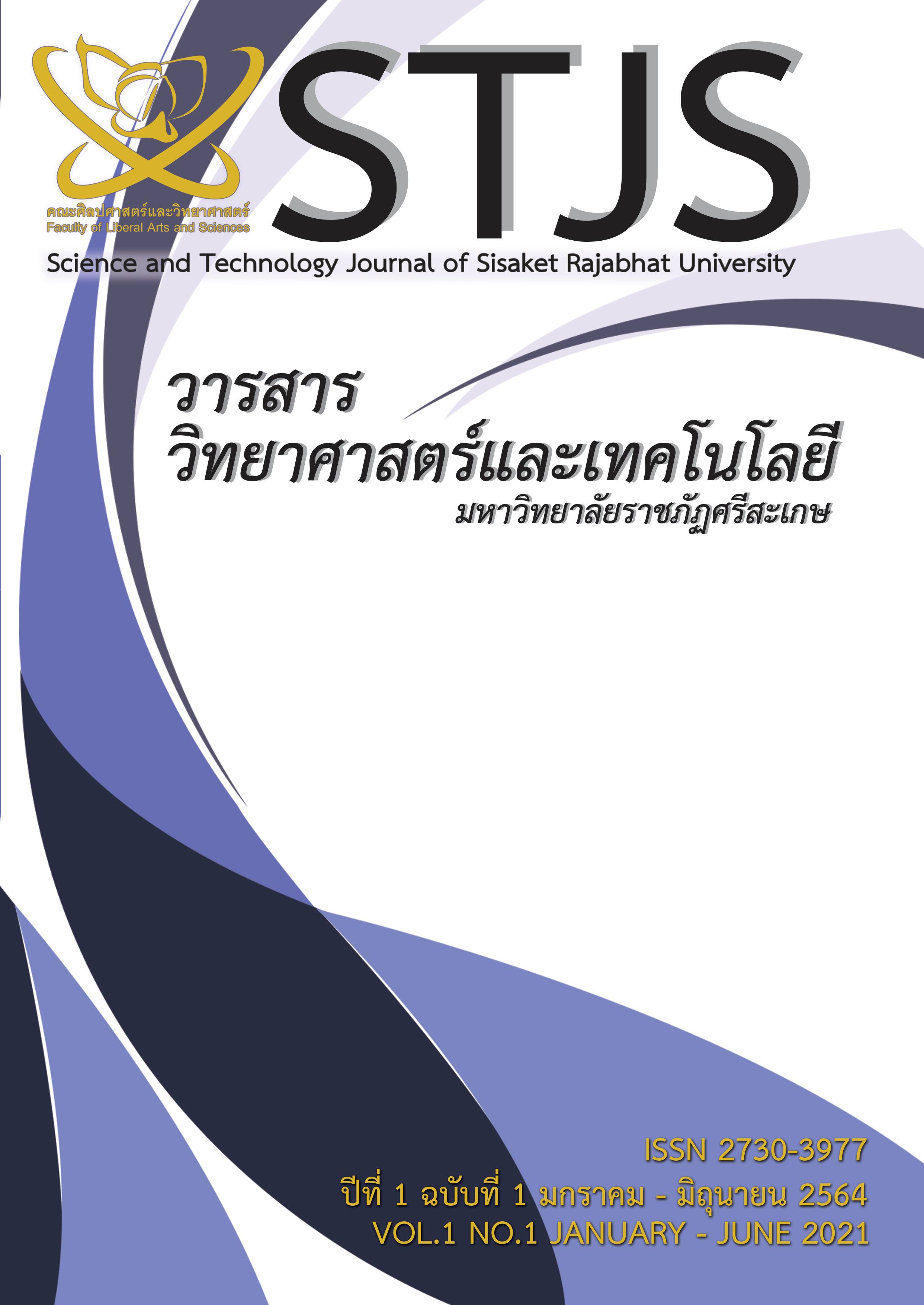ความสามารถทางโฟโตคาตาลิติกของเคลือบแก้ว-เซรามิกสำหรับกระเบื้องเซรามิก แบบเผาเร็ว
Main Article Content
บทคัดย่อ
งานวิจัยนี้ มีจุดประสงค์เพื่อศึกษาผลการเติมสารเร่งปฏิกิริยา TiO2และสารผสม TiO2 /Al2O3 ต่อความสามารถทางโฟโตคาตาลิติกของเคลือบแก้ว-เซรามิก บนกระเบื้องเซรามิกแบบเผาเร็ว เพื่อการพัฒนาผลิตภัณฑ์กระเบื้องเคลือบแก้ว-เซรามิกที่สามารถทำความสะอาดผิวตัวเองได้ โดยไม่จำเป็นต้องมีการเคลือบทับชั้น TiO2ที่ผิวนอกของกระเบื้องเคลือบเซรามิกอีกครั้ง เพื่อลดขั้นตอนและค่าใช้จ่ายด้านวัตถุดิบและพลังงานในการผลิตกระเบื้องเคลือบ แต่สามารถเพิ่มประโยชน์ในการใช้งานรวมทั้งเพิ่มความแข็งแรงทนทานของกระเบื้อง โดยศึกษาผลของปริมาณของสารเร่งปฏิกิริยา TiO2และสารผสม TiO2 /Al2O3 ตลอดจนอุณหภูมิและอัตราในการเผาที่มีผลต่อความสามารถทางโฟโตคาตาลิติกของเคลือบแก้ว-เซรามิก ที่ใช้ฟริตแก้วเป็นวัตถุดิบ ผลการศึกษาพบว่า การเติมสารเร่งปฏิกิริยา TiO2เพียงอย่างเดียวโดยไม่มีการเติม Al2O3 ในเคลือบฟริต และเคลือบแก้ว-เซรามิก ส่งผลให้ TiO2 เปลี่ยนโครงสร้างผลึกจาก Anatase ไปเป็น Rutile ทั้งหมดหลังจากเผาเคลือบที่อุณหภูมิ 1200ºC ซึ่งมีสมบัติโฟโตคาตาลิติกต่ำมาก ส่วนการเติมสารผสม TiO2 /Al2O3 ในสัดส่วน 52/48 จนถึง 48/52 โดยน้ำหนัก ในเคลือบฟริต ไม่พบเฟสเดี่ยวของ Rutile TiO2แยกออกมา แต่ TiO2 จะรวมตัวกับ BaO ในฟริตเกิดสารประกอบ Barium Titanium Oxide (BaTiOx) ซึ่งเป็นเฟสที่มีความสามารถด้านโฟโตคาตาลิติกได้ดีกว่าเฟส Rutile TiO2เคลือบฟริตผสม TiO2 /Al2O3 เผาเคลือบที่อุณหภูมิ 1200ºC พบปริมาณการสลายเมทิลีนบลู กว่า 44% จากการทดสอบต่อเนื่อง 60 นาที
Article Details

อนุญาตภายใต้เงื่อนไข Creative Commons Attribution-NonCommercial-NoDerivatives 4.0 International License.
เนื้อหาและข้อมูลในบทความที่ลงตีพิมพ์ในวารสารวิทยาศาสตร์และเทคโนโลยี มหาวิทยาลัยราชภัฏศรีสะเกษ ถือเป็นข้อคิดเห็นและความรับผิดชอบของผู้เขียนบทความโดยตรงซึ่งกองบรรณาธิการวารสาร ไม่จำเป็นต้องเห็นด้วย หรือร่วมรับผิดชอบใด ๆ
บทความ ข้อมูล เนื้อหา รูปภาพ ฯลฯ ที่ได้รับการตีพิมพ์ในวารสารวิทยาศาสตร์และเทคโนโลยี มหาวิทยาลัยราชภัฏศรีสะเกษ ถือเป็นลิขสิทธิ์ของวิทยาศาสตร์และเทคโนโลยี มหาวิทยาลัยราชภัฏศรีสะเกษ หากบุคคลหรือหน่วยงานใดต้องการนำทั้งหมดหรือส่วนหนึ่งส่วนใดไปเผยแพร่ต่อหรือเพื่อกระทำการใด จะต้องได้รับอนุญาตเป็นลายลักอักษรจากวารสารวิทยาศาสตร์และเทคโนโลยี มหาวิทยาลัยราชภัฏศรีสะเกษ ก่อนเท่านั้น
เอกสารอ้างอิง
Banerjee, S., Dionysiou, DD. And Pillai, SC. Self-cleaning applications of TiO2 by photo-induced hydrophilicity and photocatalysis. Applied Catalysis B: Environmental, 2015; 176–177: 396–428.
Murugan, K., Subasri, R., Rao, TN., Gandhi, AS., and Murty, BS. Synthesis, characterization and demonstration of self-cleaning TiO2 coatings on glass and glazed ceramic tiles. Progress in Organic Coatings, 2013; 76: 1756–1760.
Shen, W., Zhang, C., Li, Q., Zhang, W., Cao, L., and Ye, J. Preparation of titanium dioxide nano particle modified photocatalytic self-cleaning concrete. Journal of Cleaner Production, 2015; 87: 762-765.
Tezza, VB., Scarpato, M., Oliveira, LFS., and Bernardin, AM. Effect of firing temperature on the photocatalytic activity of anatase ceramic glazes. Powder Technology, 2015; 276: 60–65.
Celik, E., Keskin, I., Kayatekin, I., Azem, F., and Özkan, E. Al2O3–TiO2 thin films on glass substrate by sol–gel technique, Materials Characterization, 2007; 58, 349–357.
Mostaghimie, ME. Contreras-Garcia. Photocatalytic activity of Al2O3-doped TiO2 thin films activated with visible light on the bacteria Escherichia coli. Materials Science and Engineering B, 2010; 174: 74–79.
Barajas-Ledesma, E., Garcia-Benjume, ML., Espitia-Cabrera, I., Ortiz-Gutierrez, M., Espinoza-Beltran, FJ. Mostaghimie, J., and Contreras-Garcia, ME. Determination of the band gap of TiO2–Al2O3 films as a function of processing parameters. Materials Science and Engineering B, 2010; 174: 71–73.
Strnad, Z. Glass-Ceramic Materials. Elsevier Science Publishers Amsterdam: 9; 1986.
Manfredini, V. Ceramic tile glazes: design, trends and application. 7th Conference of the European Ceramic Society, 2001; 2031-2034.
Banijimali, S. Preparation of glass-ceramic glazes for fast firing applications by CaF2 substitution with B2O3 in the CaO-CaF2-Al2O3-SiO2 system. Ceramics International, 2013; 39: 8815-8822.
Casasola, R., Ma Rincon, J. and Romero, M. Glass-ceramic glazes for ceramic tiles: a review, Journal of Materials Science, 2012; 47: 553-582.
Midtdal, K., & Jelle, BP. Self-cleaning glazing products: A state-of-the-art review and future research pathways. Solar Energy Materials & Solar Cells, 2013; 109: 126-141.
Fujishima, A., Zhang, X., and Tryk, DA. TiO2 photocatalysis and related surface phenomena. Surface Science Reports, 2008; 63: 515–582.
ฉลาด บรรเทา และชูสิทธิ์ ศรีสุทธิกมล. กระบวนการโฟโตแคตาไลติก. 2548.
ชวิศร์ กรัณย์เมธากุล. การปรับแต่งผิวหน้าของไททาเนียมไดออกไซด์เพื่อปรับปรุงประสิทธิภาพในกระบวนการเร่งปฏิกิริยาด้วยแสง [วิทยานิพนธ์ปริญญาวิทยาศาสตรมหาบัณฑิต]. กรุงเทพมหานคร: สถาบันเทคโนโลยีพระจอมเกล้า พระนครเหนือ; 2549.
Surekha, K. & Sundararajan, S. “Self-cleaning glass” Anti-Abrasive Nanocoatings. Elsevier Ltd.: South Africa; 2015.
วรพงษ์ เทียมสอน. กระเบื้องเซรามิก เซรามิกเพื่อการก่อสร้าง และเซรามิคเพื่องานเทคนิค. กรุงเทพมหานคร: สำนักพิมพ์ โอเดียนสโตร์; 2555.
Hanaor, DAH. & Sorrell, CC. Review of the anatase to rutile phase transformation”. Journal of Materials Science, 2011; 46: 855–874.
Kumar, KNP., Keizer, K. and Burggraaf, AJ. Textural stability of titania-alumina composite membranes. Journal of Materials Chemistry, 1993; 3: 917-922.
Shirley, R., Inderwildi, OR. and Kraft, M. Electronic and optical properties of aluminium-doped anatase and rutile TiO2 from ab initio calculations. United Kingdom: Cambridge Centre for Computational Chemical Engineering, Department of Chemical Engineering, University of Cambridge; 2009.
Akhtar, MK. & Pratsinis SE. Dopants in vapor-phase synthesis of titania powders. Journal of the American Ceramic Society, 1992: 75; 3408-3416.


